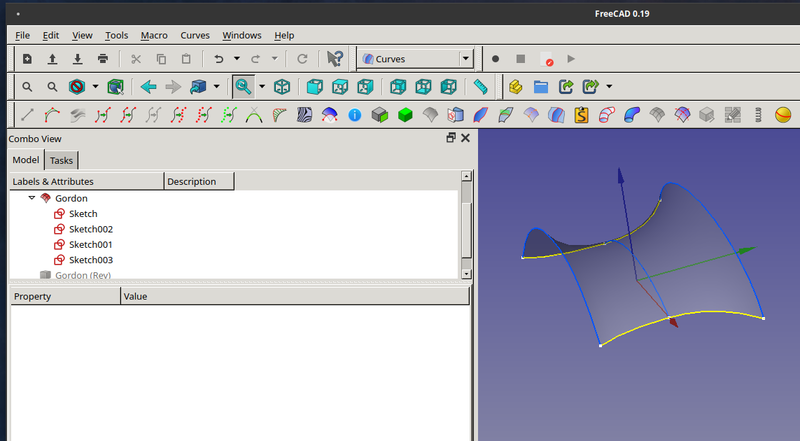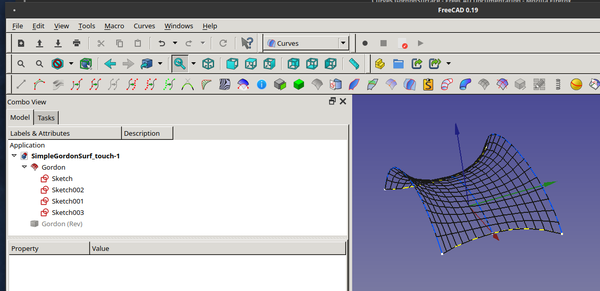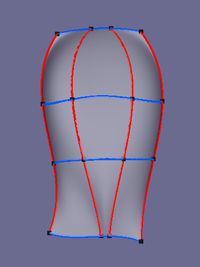Curves GordonSurface/de: Difference between revisions
(Created page with "==Hinweise==") |
(Created page with "* Die Kurven jeder Gruppe (Rippen und Schienen/Profil- und Leitkurven) sollten alle Kurven der anderen Gruppe berühren. ** Mit anderen Worten: Sie müssen ein Gitter oder ein...") |
||
| Line 62: | Line 62: | ||
==Hinweise== |
==Hinweise== |
||
* Die Kurven jeder Gruppe (Rippen und Schienen/Profil- und Leitkurven) sollten alle Kurven der anderen Gruppe berühren. |
|||
* The curves of each group (ribs and rails) should touch all curves of the other group. |
|||
** Mit anderen Worten: Sie müssen ein Gitter oder eine Netzstruktur bilden, wie hier dargestellt: |
|||
** In other words, they must form a grid or net pattern as shown here: |
|||
[[File:grid.png|200px]] |
[[File:grid.png|200px]] |
||
* Im Normalfall wird die Flächennormale der resultierenden Gordon-Fläche durch die Richtung der Profilkurven (Rippen) bestimmt. |
|||
* In general, the surface normal of the resulting Gordon surface will be determined by the direction of the ribs. |
|||
In diesem Beispiel, der Fläche auf der linken Seite, wurden die Leitkurven (Schienen) von +Y nach -Y gezogen und die resultierende Flächennormale zeigt in Richtung +Z |
|||
In this example, the surface on the left, the rails were drawn from +Y to -Y and the resulting surface normal is +Z |
|||
<br> |
<br> |
||
Auf der rechten Seite wurden die Leitkurven (Schienen) von -Y nach +Y gezogen und die resultierende Flächennormale zeigt in Richtung -Z. |
|||
On the right, the ribs are drawn from -Y to +Y, resulting in the surface normal oriented -Z. |
|||
[[File:Normals shown.png|600px]] |
[[File:Normals shown.png|600px]] |
||
Revision as of 14:18, 20 November 2022
|
|
| Menu location |
|---|
| Surfaces → Gordon surface |
| Workbenches |
| Curves |
| Default shortcut |
| None |
| Introduced in version |
| - |
| See also |
| None |
Beschreibung
The Curves GordonSurface creates a surface that skins a network of curves. This tool is part of the external workbench called Curves.
Anwendung
- A Gordon surface requires a network of lines or curves that create a support network for the surface.
- The surface will be "tented" between and over these lines.
- In the example above the blue lines (or ribs) represent the shape of the surface at different points along surface.
- These can be thought of as cross sections along the surface. Or, like supports that the surface will "tent" over.
- The yellow lines represent the extent and shape of the surface between the cross sections ("ribs") defined by the blue lines.
- These lines (blue & yellow) can be created in sketches.
- The sketches containing the blue ribs would typically have a placement offset.
- Each "rib" is in a separate sketch.
- The sketches containing the extent/shape (yellow) lines will typically reference external geometry from the "rib" sketches for accurate positioning.
- The sketches containing the blue ribs would typically have a placement offset.
- These need to be created before the next step.
- Switch to the
Curves workbench (install from
Addon Manager is necessary, if not previously installed)
- Now select all the lines of that will define the surface.
- The order of selection defines the stitching or tenting order.
- Use multi-select to select all lines defining the surface. (Left click while holding the Ctrl key.)
- Select the ribs first, in order. (In the example above, select the blue lines from left to right. or right to left.)
- Continue to hold the Ctrl key and select the extent lines. (Yellow lines in the example above.)
- To invoke the command, do one of the following:
Eigenschaften
- DatenPlacement: Can be used to adjust the placement of the resulting Gordon surface. See: Placement
- Note: The Placement properties do not adjust the placement of the curves/lines used to create the surface, only the surface.
- DatenLabel: User specified label (name) for the surface. (Default: Gordon)
- DatenOutput: Defines the output type. (Default: Surface, Options: Surface, Wireframe)
- DatenGordon>Max Ctrl Pts: (Default: 80)
- DatenGordon>Sources: User selected lines that are used to create the Gordon surface.
- DatenGordon>Tol3D: 3D tolerance (Default: 0.01)
- DatenWireframe>Samples U: Number of samples in the U direction. (Default: 16)
- This value is used to determine density of the mesh when the Output property is set to Wireframe.
- DatenWireframe>Samples V: Number of samples in the V direction. (Default: 16)
- This value is used to determine density of the mesh when the Output property is set to Wireframe.
- Gordon surface in wire frame mode, U=16, V=16
Hinweise
- Die Kurven jeder Gruppe (Rippen und Schienen/Profil- und Leitkurven) sollten alle Kurven der anderen Gruppe berühren.
- Mit anderen Worten: Sie müssen ein Gitter oder eine Netzstruktur bilden, wie hier dargestellt:
- Im Normalfall wird die Flächennormale der resultierenden Gordon-Fläche durch die Richtung der Profilkurven (Rippen) bestimmt.
In diesem Beispiel, der Fläche auf der linken Seite, wurden die Leitkurven (Schienen) von +Y nach -Y gezogen und die resultierende Flächennormale zeigt in Richtung +Z
Auf der rechten Seite wurden die Leitkurven (Schienen) von -Y nach +Y gezogen und die resultierende Flächennormale zeigt in Richtung -Z.
- Part Extrude can be used to create a solid from the surface.
- PartDesign Pad can also create a solid from the surface. Dragging the surface into a Body creates a Base Feature that can then be padded.
Limitations
TODO
Scripting
- Curves IsoCurve, Curves JoinCurve, Curves ParametricComb, Curves ParametricSolid, .................
- Erste Schritte
- Installation: Herunterladen, Windows, Linux, Mac, Zusätzlicher Komponenten, Docker, AppImage, Ubuntu Snap
- Grundlagen: Über FreeCAD, Graphische Oberfläche, Mausbedienung, Auswahlmethoden, Objektname, Programmeinstellungen, Arbeitsbereiche, Dokumentstruktur, Objekteigenschaften, Hilf FreeCAD, Spende
- Hilfe: Tutorien, Video Tutorien
- Arbeitsbereiche: Std Base, Arch, Assembly, CAM, Draft, FEM, Inspection, Mesh, OpenSCAD, Part, PartDesign, Points, Reverse Engineering, Robot, Sketcher, Spreadsheet, Surface, TechDraw, Test Framework



